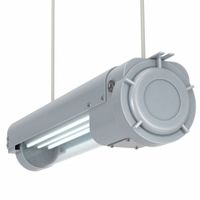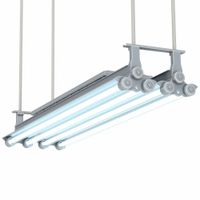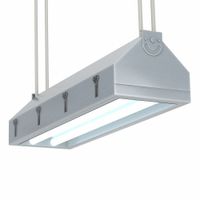Call +(254) 703 030 000 / 751 483 999 / 721 704 777
- Home
- Lighting
- Lighting Fixtures Retrofit Kits
- Hazardous Location Lighting Fixtures
- Linear Hazardous Location Light Fixtures
.....Read More
Frequently Asked Questions
What are hazardous location lighting fixtures?
Hazardous location lighting fixtures are specialized lighting solutions designed for environments where there is a risk of explosion or fire due to the presence of flammable gases, vapors, dust, or fibers. These fixtures are engineered to prevent ignition of the surrounding hazardous atmosphere, ensuring safety in potentially explosive environments.
These lighting fixtures are classified based on the type of hazardous environment they are intended for, as defined by standards such as the National Electrical Code (NEC) in the United States. The classifications include:
1. **Class I**: Locations with flammable gases or vapors, such as oil refineries or chemical plants.
2. **Class II**: Areas with combustible dust, like grain elevators or flour mills.
3. **Class III**: Environments with ignitable fibers or flyings, such as textile mills.
Each class is further divided into divisions or zones, indicating the frequency and duration of the hazardous condition. For example, Division 1 (or Zone 0/1) indicates a high likelihood of hazardous conditions, while Division 2 (or Zone 2) suggests a less frequent presence.
Hazardous location lighting fixtures are constructed with robust materials and designs to contain any sparks or heat generated within the fixture. They often feature explosion-proof housings, sealed joints, and tempered glass to prevent the escape of ignitable elements. Additionally, these fixtures are subjected to rigorous testing and certification by organizations like Underwriters Laboratories (UL) or the International Electrotechnical Commission (IEC) to ensure compliance with safety standards.
In summary, hazardous location lighting fixtures are critical for maintaining safety in environments with explosive risks, providing reliable illumination while preventing potential ignition sources.
How do hazardous location lighting fixtures prevent fires and explosions?
Hazardous location lighting fixtures prevent fires and explosions by employing several key design and engineering principles tailored to minimize the risk of igniting flammable substances present in the environment. These fixtures are specifically constructed to contain any sparks or heat generated within the fixture, preventing them from coming into contact with explosive gases, vapors, or dust.
1. **Explosion-Proof Design**: These fixtures are built with robust, heavy-duty enclosures that can withstand internal explosions. The enclosures are designed to contain any explosion that might occur within the fixture, preventing it from igniting the surrounding atmosphere.
2. **Intrinsically Safe Circuits**: The electrical components within these fixtures are designed to operate at energy levels below those required to ignite a specific hazardous atmosphere. This involves limiting the electrical and thermal energy available in the circuit.
3. **Sealed and Gasketed Enclosures**: The fixtures are equipped with seals and gaskets to prevent the ingress of flammable substances. This ensures that any potential ignition source within the fixture is isolated from the hazardous environment.
4. **Temperature Control**: The fixtures are designed to operate at temperatures below the ignition point of the surrounding hazardous materials. This involves using materials and designs that dissipate heat effectively.
5. **Non-Sparking Materials**: Components are often made from materials that do not produce sparks when struck or abraded, reducing the risk of ignition.
6. **Compliance with Standards**: These fixtures are manufactured in accordance with stringent industry standards and regulations, such as those set by the National Electrical Code (NEC) and the International Electrotechnical Commission (IEC), ensuring they meet safety requirements for hazardous locations.
By integrating these features, hazardous location lighting fixtures effectively mitigate the risk of fires and explosions in volatile environments.
What are the class and division ratings for hazardous location lighting?
Hazardous location lighting is classified based on the potential risks present in the environment. The classifications are divided into Classes, Divisions, and Groups, which help determine the appropriate lighting fixtures to use in specific hazardous areas.
**Classes:**
1. **Class I:** Locations where flammable gases or vapors are present in the air in sufficient quantities to produce explosive or ignitable mixtures. Examples include petroleum refineries and chemical plants.
2. **Class II:** Areas where combustible dust is present. This includes environments like grain elevators and flour mills, where dust can create explosive atmospheres.
3. **Class III:** Locations where easily ignitable fibers or flyings are present, but not likely to be in suspension in the air in quantities sufficient to produce ignitable mixtures. Examples include textile mills and woodworking facilities.
**Divisions:**
1. **Division 1:** Indicates that the hazardous material is present continuously, intermittently, or periodically under normal operating conditions. This division requires the highest level of protection.
2. **Division 2:** Specifies that the hazardous material is present only in abnormal conditions, such as equipment failure or accidental rupture of containers. The risk is lower compared to Division 1.
**Groups:**
- **Class I Groups:** A (Acetylene), B (Hydrogen), C (Ethylene), D (Propane)
- **Class II Groups:** E (Metal dust), F (Carbon dust), G (Grain dust)
- **Class III Groups:** No specific groups, as it deals with fibers and flyings.
Lighting fixtures for hazardous locations must be designed and certified to meet these classifications, ensuring they do not become ignition sources in potentially explosive environments.
What is the difference between Class I and Class II hazardous location fixtures?
Class I and Class II hazardous location fixtures are designed for environments where there is a risk of fire or explosion due to the presence of flammable substances. The primary difference between them lies in the type of hazardous material present.
Class I fixtures are used in areas where flammable gases or vapors are present in the air in sufficient quantities to produce explosive or ignitable mixtures. These environments are typically found in industries such as oil and gas, petrochemical, and chemical manufacturing. Class I is further divided into Divisions and Zones, which indicate the likelihood of the hazardous material being present. Division 1 (or Zone 0/1) indicates that the material is present under normal operating conditions, while Division 2 (or Zone 2) indicates that it is present only under abnormal conditions.
Class II fixtures, on the other hand, are used in areas where combustible dust is present. These environments are common in industries like grain processing, food production, and pharmaceuticals. Similar to Class I, Class II is divided into Divisions. Division 1 indicates that the dust is present during normal operations, while Division 2 indicates its presence only under abnormal conditions. The dust can be conductive or non-conductive, and the fixtures must be designed to prevent the dust from igniting.
In summary, the key difference is the type of hazardous material: Class I deals with gases and vapors, while Class II deals with dust. The design and construction of the fixtures are tailored to prevent ignition of the specific type of hazardous material present in the environment.
Why are LED lights preferred for hazardous location lighting?
LED lights are preferred for hazardous location lighting due to their inherent safety, efficiency, and durability. Firstly, LEDs operate at lower temperatures compared to traditional lighting, significantly reducing the risk of igniting flammable substances present in hazardous environments. This makes them ideal for areas with explosive gases or dust.
Secondly, LEDs are highly energy-efficient, converting a greater portion of electricity into light rather than heat. This efficiency not only reduces energy costs but also minimizes the need for frequent maintenance, which is crucial in hazardous locations where access can be challenging and costly.
Additionally, LEDs have a long lifespan, often exceeding 50,000 hours, which further reduces maintenance requirements and the associated risks of frequent bulb replacements in dangerous areas. Their solid-state construction makes them resistant to shock and vibration, ensuring reliability in environments where mechanical stress is common.
LEDs also offer superior light quality and directional lighting, providing better visibility and enhancing safety for workers by reducing shadows and glare. This is particularly important in hazardous locations where clear visibility is essential for safe operations.
Moreover, LEDs are available in various designs and can be easily integrated into explosion-proof fixtures, ensuring compliance with safety standards and regulations for hazardous locations. Their ability to function in extreme temperatures and harsh conditions without performance degradation further underscores their suitability for such environments.
In summary, the preference for LED lights in hazardous locations is driven by their safety features, energy efficiency, durability, and superior lighting quality, all of which contribute to enhanced safety and reduced operational costs.
How do fluorescent lights compare to LED lights in hazardous locations?
Fluorescent lights and LED lights differ significantly in their suitability for hazardous locations.
Fluorescent lights, while traditionally used in various settings, have several drawbacks in hazardous environments. They contain mercury, which poses a risk if the bulb breaks, potentially releasing toxic vapors. Additionally, fluorescent lights are more fragile and prone to breakage, increasing the risk of accidents in volatile areas. Their startup time can be slow, especially in cold conditions, and they often require ballasts, which can fail and need maintenance. Fluorescent lights also have a shorter lifespan compared to LEDs, leading to more frequent replacements and increased maintenance in hazardous locations.
LED lights, on the other hand, are more robust and better suited for hazardous environments. They are solid-state lights, meaning they are more durable and resistant to shock and vibration. LEDs do not contain hazardous materials like mercury, making them safer in case of breakage. They offer instant illumination without warm-up time, which is crucial in emergency situations. LEDs are highly energy-efficient, reducing energy consumption and heat output, which is beneficial in environments where temperature control is critical. They have a longer lifespan, reducing the need for frequent replacements and maintenance, which is advantageous in hazardous locations where access may be difficult or dangerous.
Overall, LED lights are generally preferred over fluorescent lights in hazardous locations due to their durability, safety, efficiency, and longer lifespan.
What are the group ratings for hazardous location lighting fixtures?
Hazardous location lighting fixtures are classified into groups based on the type of hazardous material present in the environment. These groups help in selecting the appropriate lighting fixtures to prevent ignition of flammable substances. The classification is as follows:
1. **Group A**: This group includes environments with acetylene, a gas with a high explosion risk due to its low ignition energy and wide flammable range.
2. **Group B**: This group covers areas with hydrogen or gases with similar characteristics, such as manufactured gas. These gases have a high explosion risk due to their low molecular weight and high diffusion rate.
3. **Group C**: This group is for environments containing ethylene or gases with similar properties. These gases have a moderate explosion risk and are less volatile than those in Groups A and B.
4. **Group D**: This group includes areas with propane, gasoline, or other gases and vapors of similar characteristics. These are common industrial gases with a lower explosion risk compared to Groups A, B, and C.
5. **Group E**: This group is for environments with combustible metal dusts, such as aluminum or magnesium. These dusts can create explosive atmospheres when suspended in air.
6. **Group F**: This group includes areas with carbonaceous dusts, such as coal or coke dust. These dusts can ignite easily and create explosive atmospheres.
7. **Group G**: This group covers environments with combustible dusts not included in Groups E and F, such as grain, flour, or plastic dusts. These dusts can also form explosive mixtures in air.
These group ratings are essential for ensuring safety in hazardous locations by selecting lighting fixtures that are designed to prevent ignition of the specific hazardous materials present.


